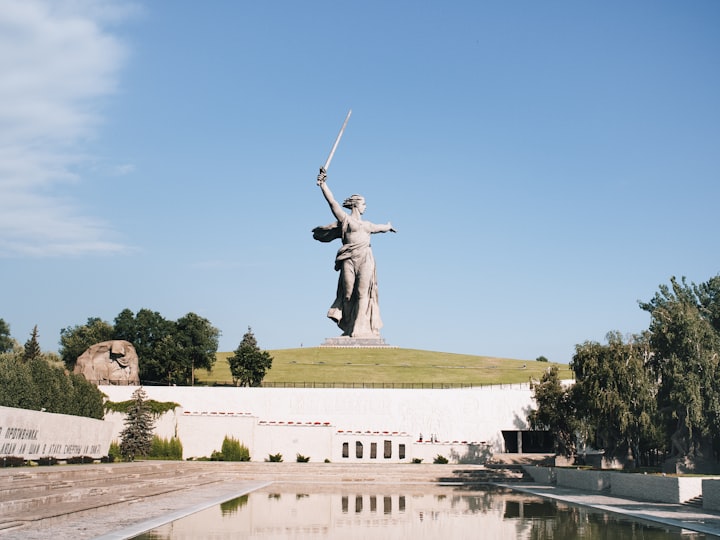
The Soviet Union was a vast northern Eurasian empire that existed from 1917/22 to 1991. It spanned from the Baltic and Black seas to the Pacific Ocean and was made up of 15 Soviet Socialist Republics (S.S.R.’s): Armenia, Azerbaijan, Belorussia (now Belarus), Estonia, Georgia, Kazakhstan, Kirgiziya (now Kyrgyzstan), Latvia, Lithuania, Moldavia (now Moldova), Russia, Tajikistan, Turkmenistan, Ukraine, and Uzbekistan. The capital was Moscow, which remains the capital of Russia to this day.
During its peak from 1946 to 1991, the U.S.S.R. spanned approximately 8,650,000 square miles (22,400,000 square kilometers), which was seven times larger than India and two and a half times bigger than the United States. This vast country covered nearly one-sixth of the Earth's land surface, encompassing the eastern portion of Europe and a significant portion of northern Asia.
The U.S.S.R. spanned over 6,800 miles (10,900 kilometers) from its westernmost point near Kaliningrad on the Baltic Sea to its easternmost point at Cape Dezhnev on the Bering Strait. This vast expanse covered 11 of the world's 24 time zones, showcasing its immense size. From north to south, the U.S.S.R. stretched approximately 2,800 miles from Cape Chelyuskin to Kushka on the Afghan border. It's worth noting that almost half of the U.S.S.R.'s territory lay north of the 60° N latitude, aligning with the same latitude as Alaska, Baffin Island, and Greenland.
In addition to possessing the world's lengthiest coastline, the U.S.S.R. boasted the longest borders. Towards the north, the nation was enclosed by the Arctic Ocean, while the eastern boundaries were marked by the Pacific Ocean. To the south, the U.S.S.R. shared borders with North Korea, Mongolia, China, Afghanistan, Iran, and Turkey. Along the southern frontier, three seas were present: the Caspian Sea, the largest inland sea globally, along with the predominantly landlocked Black Sea and Sea of Azov. Romania, Hungary, Czechoslovakia, Poland, Finland, and Norway were situated to the west.
The Russian Empire of the tsars was succeeded by the U.S.S.R. after the 1917 Revolution. The former empire's territory saw the establishment of four socialist republics: the Russian and Transcaucasian Soviet Federated Socialist Republics, as well as the Ukrainian and Belorussian Soviet Socialist Republics. On December 30, 1922, these constituent republics came together to form the U.S.S.R. Over the following years, additional union republics (Soviet Socialist Republics) were created. The Turkmen and Uzbek S.S.R.'s were established in 1924, followed by the Tadzhik S.S.R. in 1929, and the Kazakh and Kirgiz S.S.R.'s in 1936. In the same year, the Transcaucasian Republic was dissolved, and its territory was divided among three new republics: the Armenian, Azerbaijan, and Georgian S.S.R.'s. By 1940, the Karelo-Finnish, Moldavian, Estonian, Latvian, and Lithuanian S.S.R.'s were also established. The Karelo-Finnish S.S.R. later became an autonomous republic in 1956, resulting in a total of 15 union republics (soyuznye respubliki). Additionally, as of 1990, the U.S.S.R. consisted of 20 autonomous republics (avtonomnye respubliki), 8 autonomous provinces (avtonomnye oblasti), 10 autonomous districts (avtonomnye okruga), 6 regions (kraya), and 114 provinces (oblasti).
The political structure of the U.S.S.R., as outlined in the constitution from the 1930s to October 1977, was based on the Soviets (Councils) of People’s Deputies. These councils were present at all levels of the administrative system, with the Supreme Soviet of the U.S.S.R. in Moscow overseeing the entire Soviet Union. The Supreme Soviet consisted of two chambers: the Soviet of the Union, comprising 750 members elected from single-member constituencies, and the Soviet of Nationalities, with 750 members representing different political divisions. Elections typically offered limited choice, with candidates mainly from the Communist Party of the Soviet Union (CPSU), which was considered the dominant force in Soviet society until the amendment of Article 6 in March 1990. While legislation theoretically required approval from both chambers of the Supreme Soviet, decisions were effectively made by the Presidium of the Supreme Soviet, heavily influenced by the Politburo of the CPSU, and unanimously endorsed by deputies. The role of the soviets in individual republics and territories was mainly to implement the decisions of the Supreme Soviet of the U.S.S.R.
The political system was characterized by its authoritarian and highly centralized nature, which extended to the economic system as well. The economic foundation of the U.S.S.R. was based on "Socialist ownership of the means of production, distribution, and exchange," and the entire country's economy was controlled through a series of five-year plans that set production targets for all sectors. Significant and impactful changes took place in the late 1980s and early '90s, brought about by the implementation of perestroika ("restructuring") and glasnost ("openness"). On the economic front, the planned and highly centralized command economy was gradually replaced by the introduction of market economy elements. However, this transition proved to be challenging and resulted in declining production in various sectors, as well as distribution issues. In the political sphere, amendments were made to the constitution in 1988, replacing the old Supreme Soviet with the Congress of People's Deputies of the U.S.S.R. This new congress consisted of 2,250 members, with one-third elected through constituencies, one-third representing political territories, and the remaining third representing "all-union social organizations" such as trade unions, the CPSU, and the Academy of Sciences. The electoral process allowed voters to choose from a range of candidates, leading to the election of many non-Communists. The Congress of People's Deputies then elected a new Supreme Soviet comprising 542 members and selected the chairman of the body, who would serve as the executive president of the U.S.S.R. Similar congresses of People's Deputies were also established in each republic.
These congresses could be accurately described as parliaments, and they participated in lively debates regarding the economic and political future of the nation. Starting from 1989, conflicts arose between the U.S.S.R. parliament and those of the individual republics, primarily concerning the powers of the center (the U.S.S.R. government) and the republics. These conflicts were worsened by the resurgence of ethnic nationalism and the growing demands for autonomy and even complete independence. After the failed coup in August 1991, in which the CPSU was heavily involved, the party itself was abolished. By December 1991, the Union of Soviet Socialist Republics had essentially ceased to exist, leaving the fate of its territories and people uncertain. Three republics—Estonia, Latvia, and Lithuania—had achieved full independence and were recognized as sovereign states internationally, while several others were seeking independence. Efforts were made, led by Mikhail Gorbachev, the president of the Soviet Union, to establish a new "Union of Sovereign States" with some level of integration in foreign policy, defense, and economic matters, but the remaining 12 republics failed to reach an agreement. Regardless of the legal standpoint, the union republics had started to act as if they were independent states, engaging in negotiations with each other and bypassing the weakened central government. This process culminated on December 8, 1991, with the signing of an agreement between the three Slavic republics of Russia, Ukraine, and Belarus to establish the Commonwealth of Independent States (CIS), which included a shared foreign affairs and defense policy. The CIS later expanded to include all the remaining republics except Georgia, but significant challenges were encountered in reaching consensus on policies. The future remained uncertain, but there was no dispute with the statement made by the Commonwealth's leaders that "the U.S.S.R. has ceased to exist as a geopolitical reality."
This article provides a historical account of the Union of Soviet Socialist Republics spanning from 1917 to 1991. For information on the geography and history of the former Soviet Socialist republics, please refer to the articles on Moldova, Estonia, Latvia, Lithuania, Kazakhstan, Kyrgyzstan, Tajikistan, Turkmenistan, Uzbekistan, Russia, Armenia, Azerbaijan, Georgia, and Ukraine.






Comments
There are no comments for this story
Be the first to respond and start the conversation.